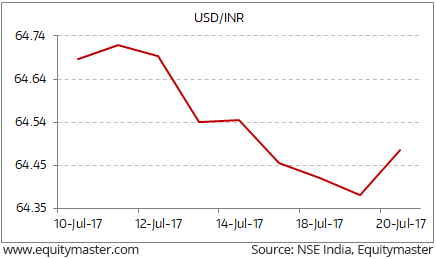- Home
- Todays Market
- Indian Stock Market News July 21, 2017
Sensex Trades Marginally Higher; IT Stocks Witness Buying Fri, 21 Jul 11:30 am
Stock markets in India are presently trading marginally higher. Sectoral indices are trading on a mixed note with stocks in the IT sector and energy sector witnessing maximum buying interest. Telecom stocks are trading in the red.
The BSE Sensex is trading up 122 points (up 0.4%) and the NSE Nifty is trading up 35 points (up 0.4%). The BSE Mid Cap index is trading up by 0.3%, while the BSE Small Cap index is trading up by 0.4%. The rupee is trading at 64.30 to the US$.
In the news from currency markets, the dollar is witnessing selling pressure today. Most of the losses are seen on the back of the ECB meet, where European Central Bank chief Mario Draghi said that no exact date had been set for discussing any changes to the ECB's ultra-easy monetary policy. The comments meant losses for dollar against the euro currency.
The dollar also traded on a negative note against the rupee this week. It opened its session lower on the back of weak global cues and continued to witness losses during the start of the week. During the end of the week, the dollar continued its downtrend and ended its session in the red.
Dollar Extend Losses

One must note that the rupee is witnessing buying interest of late. The appreciation in the rupee comes as a welcome breather for importers in India. A softer rupee helps importers to buy goods and services at a cheaper rate. This is vital for a developing economy that relies heavily on imports. This bodes well for the Indian economy as higher imports normally mean increased economic activity.
But on the other hand, the rise in rupee can spell trouble for exporters. The exporters are at a disadvantage owing to the currency appreciation as this renders their produce expensive in the international markets as compared to other competing nations whose currencies haven't appreciated on a similar scale. This tends to take away a part of the advantage from Indian companies, which they enjoy due to their cost competitiveness.
Nonetheless, a stronger rupee will pull down commodity prices. This will help in keeping a tab on the rising inflation.
While there are advantages as well as disadvantages of a rising rupee, one needs to understand whether the rise in the rupee is sustainable to derive any reasonable conclusion at this stage.
For one, the weakness of the US dollar is largely due to the relative unattractiveness of US assets. This is in part due to a very low interest rate regime prevalent in the US economy. Already there are indications that this low interest rate regime may not be sustainable for long. This means that US interest rates may go up and this may likely strengthen the US dollar.
To keep a tab on the movements in rupee-dollar and other currencies, you can read the stock market commentary from the Daily Profit Hunter team. Their commentary tracks the developments in the global economy as well as stock, currency and commodity markets.
In the news from the cement sector, a report by ICRA has stated that India's cement demand growth is expected to recover to around 5% during FY18. The rise here, as per ICRA, would come on the back of a pick-up in the infrastructure and housing segments. This rise would be against the 1.2% decline seen in cement demand during FY17.
One must note the cement industry witnessed marginal signs of improvement during the April-June quarter, after the demonetisation effect in 1QCY17.
Also, the implementation of GST bodes well for cement companies. Cement has been taxed at 28% under the GST regime, as compared to 30-31% in the previous system of taxation. Following this, cement companies have reduced cement prices effective from July 1 to pass on the benefit to consumers.
Under GST, there has been a price reduction of around 5% on the bagged cement sold in the open market (trade segment) (Source: Indiainfoline). Therefore the implementation of GST is likely to bring opportunities of growth for the cement industry. Furthermore, the industry will benefit from lower logistics costs because of elimination of blockage time at state check-posts under the GST system.
Speaking of GST, the Goods and Services Tax became the order of the day at the start of this month. And all these months we have been subjected to a relentless propaganda by the government and the supporters of the GST, on how it will change our world, only for good.
Our colleague Vivek Kaul, has studied the finer aspects of the GST and predicted what could go right and wrong.
Download his special report - The Good, the Sad and the Terrible (GST).
For information on how to pick stocks that have the potential to deliver big returns, download our special report now!
Read the latest Market Commentary


Equitymaster requests your view! Post a comment on "Sensex Trades Marginally Higher; IT Stocks Witness Buying". Click here!
Comments are moderated by Equitymaster, in accordance with the Terms of Use, and may not appear
on this article until they have been reviewed and deemed appropriate for posting.
In the meantime, you may want to share this article with your friends!